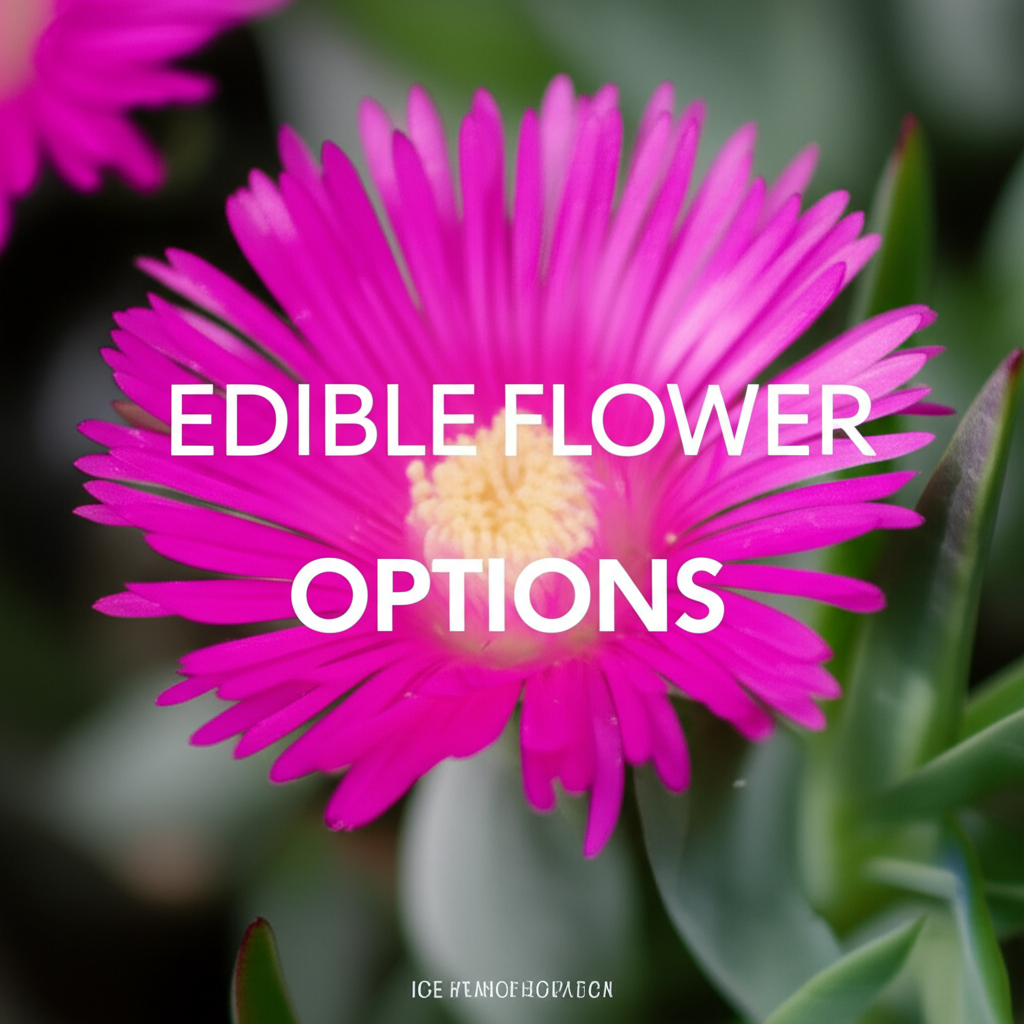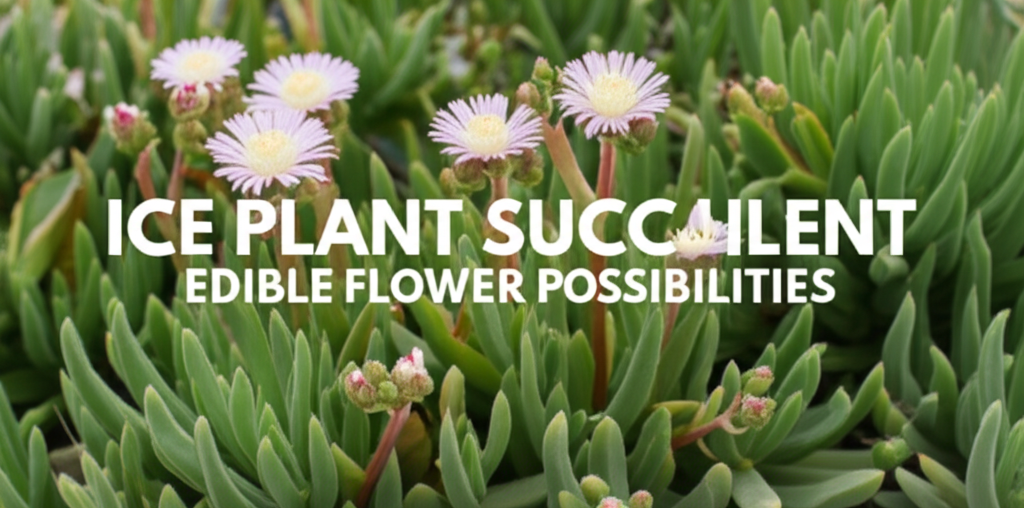Introduction: More Than Just a Pretty Face
Ice plants, scientifically known as members of the Aizoaceae family, are a fascinating group of succulents renowned for their unique, water-filled epidermal cells that give them a glistening, “icy” appearance. While their striking foliage and vibrant flowers have long made them popular in xeriscaping and ornamental gardens, there’s a burgeoning interest in exploring their culinary potential. Specifically, the possibility of consuming ice plant succulent flowers is gaining traction, offering a novel and visually appealing addition to the world of edible flora. This article delves into the world of edible ice plant flowers, examining their taste, potential uses, and important considerations for cultivation and consumption.
Understanding Ice Plants: A Diverse Family

The Aizoaceae family is incredibly diverse, encompassing thousands of species with a wide array of forms and characteristics. Many of these plants originate from arid regions of the world, particularly South Africa, where they have evolved remarkable adaptations to survive extreme conditions. While not all ice plants are created equal in terms of edibility, several species are known to have edible components, including their flowers.
Key Characteristics of Edible Ice Plant Varieties
When considering ice plants for their edible flowers, it’s crucial to identify species with a known history of safe consumption. Some of the most commonly cited edible varieties include:
- Delosperma cooperi (Cooper’s Ice Plant): Known for its vibrant pink to purple flowers and trailing habit.
- Mesembryanthemum crystallinum (Common Ice Plant/Crystal Plant): Historically used for its salty-tasting leaves and flowers.
- Dorotheanthus bellidiformis (Livingstone Daisy): While technically in the Aizoaceae family, it’s often grouped with ice plants and features a dazzling array of brightly colored daisy-like flowers.
It’s important to note that while many succulents are generally safe, the edibility of specific plant parts can vary significantly. Always ensure positive identification before consuming any part of a plant.
The Culinary Appeal of Ice Plant Flowers
The allure of ice plant flowers in a culinary context lies in their unique flavor profile and visual appeal. Many gardeners and chefs are seeking new and exciting ingredients, and these floral gems offer just that.
Flavor Profile: A Hint of Sweetness and Salt
The taste of ice plant flowers is often described as subtly sweet with a delicate, slightly salty, or mineral-like undertone. This nuanced flavor can be attributed to the plant’s adaptation to arid environments, where it may accumulate minerals from the soil. The subtle saltiness is not overpowering but rather provides an interesting counterpoint to the sweetness, making them a versatile addition to various dishes.
- Sweetness: Generally mild, not sugary.
- Saltiness: A subtle, natural salinity, akin to sea salt.
- Texture: Often delicate and crisp when fresh.
Some enthusiasts also report a faint, cucumber-like freshness, particularly in certain varieties. The combination of these elements makes ice plant flowers a sophisticated ingredient that can elevate both savory and sweet creations.
Visual Delight: Adding a Pop of Color
Beyond their taste, ice plant flowers are a visual triumph. They come in a stunning spectrum of colors, including vibrant pinks, purples, oranges, yellows, and whites. Their delicate, often star-shaped or daisy-like appearance makes them perfect for garnishing salads, desserts, and even cocktails.
- Salads: Adding a burst of color and subtle flavor to green salads, fruit salads, and grain bowls.
- Desserts: A beautiful and unique garnish for cakes, tarts, and pastries.
- Beverages: Enhancing the aesthetic appeal of cocktails and mocktails.
Nutritional Considerations (Preliminary Insights)
While research into the specific nutritional content of ice plant flowers is still developing, preliminary observations suggest they may contain beneficial compounds often found in edible flowers. These could include:
- Vitamins
- Minerals
- Antioxidants
Further scientific analysis is needed to confirm the precise nutritional profile and potential health benefits.
Key Facts and Comparison of Edible Ice Plant Flowers
To better understand the differences and similarities, here’s a table comparing some common edible ice plant varieties and their flowers:
| Species | Common Name(s) | Flower Color(s) | Flavor Notes | Edible Parts | General Growth Habit |
|---|---|---|---|---|---|
| Delosperma cooperi | Cooper’s Ice Plant | Pink, Purple, Magenta | Mildly sweet, slightly mineral | Flowers, Young Leaves | Low-growing, spreading groundcover |
| Mesembryanthemum crystallinum | Common Ice Plant, Crystal Plant | White to Pale Pink | Slightly salty, refreshing | Flowers, Leaves, Stems | Spreading, low-lying annual/biennial |
| Dorotheanthus bellidiformis | Livingstone Daisy | Various (Pink, Orange, Yellow, Red, White) | Mildly sweet, crisp | Flowers | Low-growing, spreading annual |
| Lampranthus spp. | Ice Plant (general) | Various (Pink, Orange, Yellow, Red, Purple) | Subtle sweetness | Flowers | Shrubby, spreading succulents |
Note: Edibility should always be confirmed with reliable sources.
Cultivation for Edible Flowers
Growing ice plants for their edible flowers requires a slightly different approach than simply planting them for ornamental purposes. The focus shifts to fostering healthy growth that encourages abundant and clean blooms.
Ideal Growing Conditions
Ice plants thrive in conditions that mimic their native arid environments.
- Sunlight: Full sun is essential for most ice plant varieties to produce the most vibrant and plentiful flowers. Aim for at least 6-8 hours of direct sunlight per day.
- Soil: Well-draining soil is paramount. A sandy or gravelly mix, or a cactus and succulent potting mix, is ideal. Poor drainage can lead to root rot.
- Watering: These are drought-tolerant plants. Water thoroughly but infrequently, allowing the soil to dry out completely between waterings. Overwatering is a common mistake and can be detrimental.
- Temperature: Most ice plants prefer warm temperatures and are generally not frost-tolerant. In colder climates, they may need to be brought indoors during winter or treated as annuals.
- Fertilization: Ice plants generally do not require heavy fertilization. A light feeding with a diluted, balanced fertilizer during the growing season can be beneficial, but avoid over-fertilizing, which can lead to leggy growth and fewer flowers.
Harvesting Edible Flowers
The key to harvesting edible ice plant flowers for the best flavor and appearance is timing and technique.
- Timing: Harvest flowers in the morning after the dew has dried but before the heat of the day. This is when the flowers are typically most turgid and flavorful.
- Selection: Choose fully opened, vibrant flowers. Avoid any that show signs of wilting, damage, or discoloration.
- Method: Gently pluck the flowers from the stem using your fingers or small, sharp scissors. Try to avoid damaging the surrounding foliage.
- Cleaning: Once harvested, gently rinse the flowers under cool, running water to remove any dirt or insects. Pat them dry carefully with a paper towel.
- Storage: For immediate use, keep them in a cool, dry place. For longer storage, you can place them in a single layer on a paper towel in an airtight container in the refrigerator for a day or two, but fresh is always best.
Potential Culinary Applications
The delicate flavor and striking appearance of ice plant flowers open up a world of culinary possibilities. They can be used both as a decorative garnish and as an ingredient that contributes subtle flavor notes.
Salads and Appetizers
Ice plant flowers are a natural fit for salads. Their subtle saltiness complements the greens, and their vibrant colors add visual appeal.
- Toss them into mixed green salads with a light vinaigrette.
- Garnish caprese salads for a unique twist.
- Use them to top crostini with goat cheese or ricotta.
- Incorporate them into fruit salads for a surprising savory element.
Desserts and Sweets
The gentle sweetness of ice plant flowers can also be a delightful addition to desserts.
- Candied ice plant flowers make for exquisite edible decorations on cakes and cupcakes.
- Sprinkle fresh flowers over sorbets or ice cream.
- Incorporate them into fruit tarts or panna cotta.
Beverages and Cocktails
For a touch of elegance, ice plant flowers can be used to adorn drinks.
- Float a flower in champagne or sparkling wine.
- Freeze them into ice cubes for visually stunning cocktails.
- Use them as a garnish for herbal teas or infused water.
Important Considerations and Safety
While the prospect of eating ice plant flowers is exciting, it’s crucial to approach it with caution and informed practices.
Identification is Key
As with any foraged or newly introduced edible plant, positive identification is paramount.
- Know Your Plant: Only consume flowers from ice plant varieties that are confirmed to be edible.
- Source Matters: If purchasing plants, ensure they are from reputable nurseries that do not use pesticides or herbicides on edible varieties.
- Avoid Treated Plants: Never consume flowers from plants that have been treated with chemical pesticides or fertilizers, as these can be toxic.
Potential for Misidentification and Allergies
The succulent family is vast, and some plants can look quite similar.
- Cross-Contamination: Be mindful of other non-edible plants growing nearby that could contaminate your harvest.
- Allergies: As with any new food, it’s wise to try a small amount first to check for any allergic reactions. Individuals with existing plant-based allergies should exercise extra caution.
Cultivation Practices for Edibility
The way a plant is grown directly impacts the safety and quality of its edible parts.
| Aspect | Best Practice for Edible Flowers | Potential Risks (If Not Followed) |
|---|---|---|
| Pesticides/Herbicides | Avoid entirely. Use organic pest control methods if necessary (e.g., neem oil, insecticidal soap – ensure they are food-safe). | Toxicity, harmful chemical residues on flowers. |
| Fertilizers | Use only organic, food-grade fertilizers sparingly. | Chemical buildup, potential for “burning” the delicate flowers or affecting taste. |
| Soil Quality | Use sterile, well-draining potting mix or ensure garden soil is free from contaminants. | Heavy metal contamination, uptake of pollutants from soil. |
| Water Source | Use clean, potable water. | Contamination from untreated water sources. |
Tips for the Aspiring Ice Plant Flower Chef
For those eager to experiment with ice plant flowers in their kitchen, here are a few tips to get started:
- Start Simple: Begin by using the flowers as a garnish on familiar dishes to get a feel for their flavor and texture.
- Pairing Flavors: Consider flavors that complement their subtle sweetness and saltiness, such as citrus, mild cheeses, fresh herbs, and berries.
- Don’t Overpower: Their flavor is delicate, so avoid pairing them with intensely strong ingredients that might mask their unique profile.
- Experiment with Candying: Candying the flowers is a popular method that preserves them and creates beautiful decorations.
- Keep it Fresh: Ice plant flowers are best used fresh for optimal flavor and appearance.
Conclusion: A Blossoming Culinary Frontier
The exploration of ice plant succulent flowers as an edible ingredient is an exciting development in the world of gastronomy. Their unique flavor, stunning visual appeal, and easy cultivation make them a promising addition to the home garden and the culinary landscape. As interest grows, further research into their nutritional properties and specific culinary applications will undoubtedly unlock even more potential. By prioritizing safety, proper identification, and mindful cultivation, home cooks and adventurous chefs alike can enjoy the delicate beauty and subtle taste of these blooming edible gems. The ice plant flower is more than just a pretty face; it’s a potential delicacy waiting to be discovered and savored.


